 Ben, Colin, & Steph on Bike to Work Day.
Ben, Colin, & Steph on Bike to Work Day. River view along the Mississippi River Regional Trail.
River view along the Mississippi River Regional Trail.“There is no trail maintenance during the winter, including plowing and clearing. Please follow the posted detour routes. Thank you for your patience during this process.”
 Map of the closed trail section. Note the detour (yellow) takes riders across the river–opposite the side Dero is located.
Map of the closed trail section. Note the detour (yellow) takes riders across the river–opposite the side Dero is located.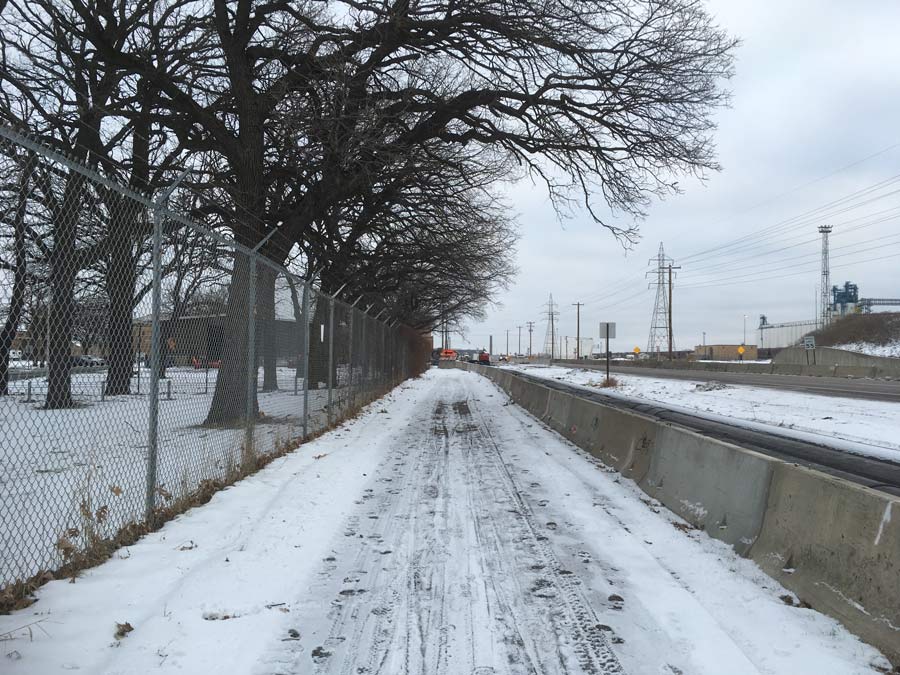 View of the plowed trail.
View of the plowed trail. A plowed trail means Bri is happy. Thumbs up!
A plowed trail means Bri is happy. Thumbs up!
Campus Bike Parking: An Introductory Course
A+ Bike Parking
First and foremost, quality bike parking on any campus means more than just something to lock to (that would barely qualify as a passing grade). Good bike racks and bicycle storage should be u-lock compatible, protect students’ bikes from the elements, and be numerous enough to meet demand. Everyone hates searching for a spot to park when you’re already late for class!
Bike shelters are a great example of quality bicycle storage that protects students’ bikes from bad weather. In the above photo, a student at St. Olaf College in Northfield, MN checks out a bike from the campus bike share program. The Kolo Shelter is a perfect solution for fitting two-tiered systems, like the Dero Decker, to double up on bike parking capacity.
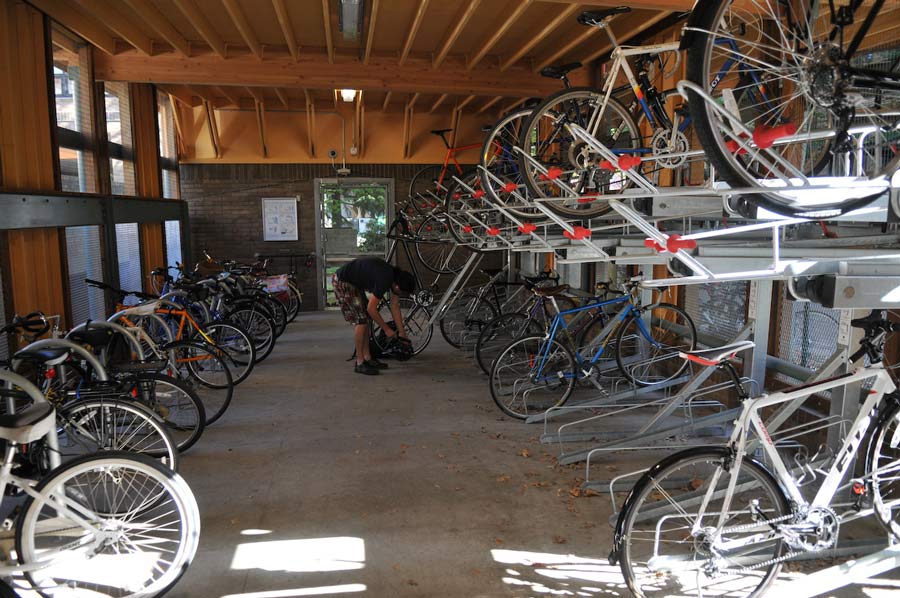 A bike room at Portland State University.
A bike room at Portland State University.It should be no surprise that bike rooms receive an “A” grade in our book. Fully enclosed, secure parking, like in Portland State University’s Bike Garage, includes both two-tier and floor-mounted parking options, which accommodates many different types of bikes. Many bike rooms are furnished with public bike repair amenities, such as the Fixit repair stand and Air Kit bike pumps.
Keep Students Rolling
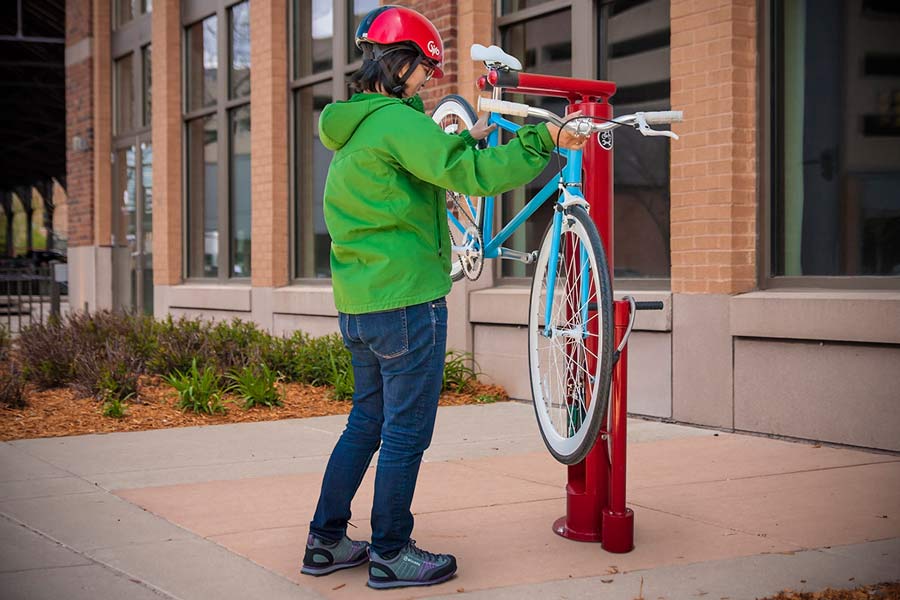 The Dero Fixit public bike repair stand.
The Dero Fixit public bike repair stand.Bike repair stands don’t only belong in bike rooms. They’re perfect for busy bike paths, in or outside student residence halls, and in central public spaces on campus. The Dero Fixit provides all the necessary tools so students can perform basic bike maintenance. Add either an Air Kit 2 or Air Kit 3, and students have the ability to repair flats or top off the air in their tires.
Public bicycle repair stands are also great educational opportunities. Many campuses teach fix-a-flat or tune-up classes at the stands, so students can learn how to use all of the tools available to them. Here are a few videos that colleges and universities made to highlight their campus bike repair:
University of Iowa, UT Arlington, Tufts University, Penn State, University of Oregon.Encourage Active Transportation
College campuses have high numbers of active people in a concentrated area. Dero ZAP is our automated commuter tracking program and is used to incentivize and gather data on students’ commutes at campuses across the country.
At the University of Minnesota, Dero ZAP has been used to track both faculty and students’ commutes since 2012. Steve Sanders, Alternative Transportation Manager at the U, says that “Since the program’s inception in 2012 we’ve seen increased bicycle mode share and a deepened cycling culture. We’ve also been extremely pleased by how many women are actively participating – over 40% of participants are women.”
For more information on Dero ZAP, watch our “How it works” video.
Cultivate Campus Identity
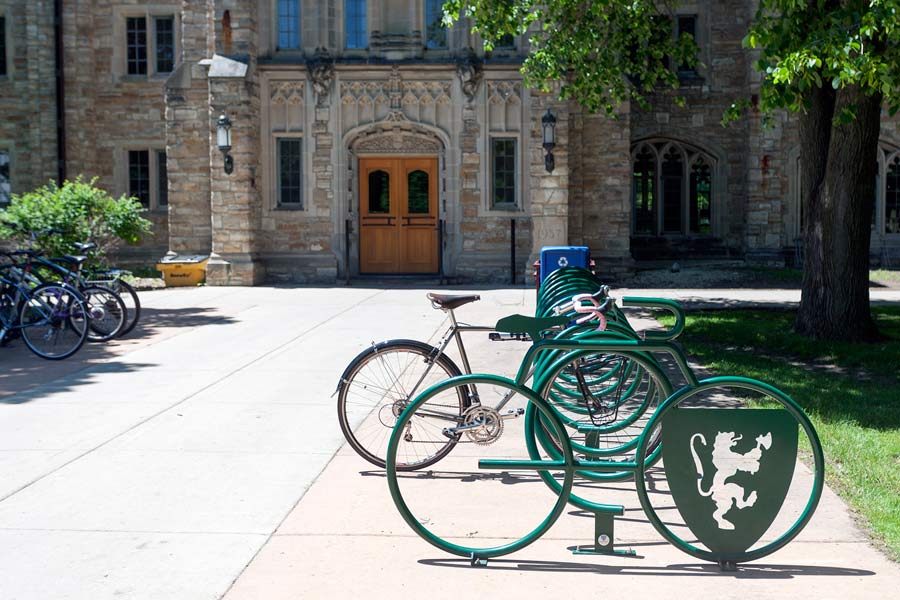 St. Olaf Collage chose to highlight their logo in this custom laser-cut Bike Bike Rack.
St. Olaf Collage chose to highlight their logo in this custom laser-cut Bike Bike Rack.As more colleges and universities invest more resources into their biking infrastructure, custom racks are a great way for schools to stand out and add a personalized touch to their bike parking. At Dero, we’ve had years of experience making custom projects a reality. All we need is your school’s logo or mascot.
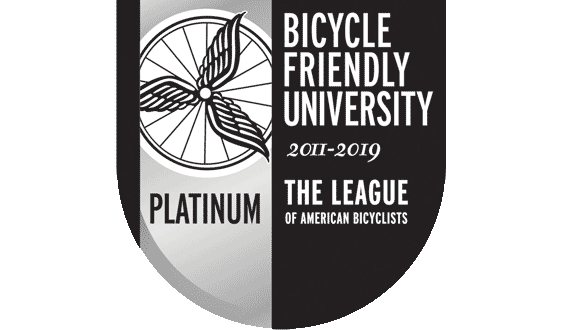
Feel confident you’ve mastered Campus Bike Parking 101? Time to take your biking game to the next level: consider applying for Bicycle Friendly University (BFU) status through the League of American Bicyclists. Dero has been a Gold certified Bike Friendly Business for over 4 years (you can read our story here), and we hope you “ace” your BFU application!
What Makes a Good Bike Rack?

LOCATION, LOCATION, LOCATION
Bicycle parking should be located in an easily accessible area that is well-lit, secure, and preferably sheltered. It should be placed as close to the building entrance(s) as possible, or at least as close as the nearest car parking. When done well, bike parking can enhance a space, make people with bikes feel welcomed, and even encourage more people to ride. When done poorly it can convey indifference, cause frustration, be an eyesore, or even a hazard. Imagine having roads, but nowhere to park cars. As cities increasingly develop bike paths, cycle tracks, and green lanes, bike parking is essential. Otherwise, as any urban planner will tell you, we are welcoming chaos to our public spaces. Good ordinances and good planning help municipalities and organizations determine where bikes get parked. Transit hubs and businesses are the obvious places for bike racks, but it is also important to observe cities in the same way the esteemed Jane Jacobs did by watching how people interact with places, which leads us to know where bike racks function best. Some underused bike parking investments have been mistaken as failures, but the placement is usually wrong, not the bike rack. Bike parking that is out of the way often gets ignored.SECURITY AND STABILITY ARE KEY
A bike should be able to rest firmly against a bike rack – two points of contact is ideal. The frame and front wheel, which can swivel, need to rest fully supported against the rack and be able to lock to the bike rack with a U-style or similarly secure lock. This provides security and stability – the essentials of good bike parking. When selecting bike parking, some basic questions will help determine a good solution: Is it intended for short-term use (less than 2 hours) or long-term (more than 2 hours)? Convenience trumps shelter for short-term parking, while protection from the elements is prioritized in long-term settings. How many bicycles need to be parked? What are the location and dimensions of the space? What is the budget? There are bike racks designed to best fit sidewalks, streetscapes, inside buildings and out. There are horizontal, vertical, stacked, and custom options all designed to meet various needs and spaces. Bike lockers, shelters, and rooms are best for long-term bike parking for additional security and weather protection.GOVERNMENT’S ROLE
Local government can play a critical role in making sure bike parking is implemented properly. Their tools include requirements in the city code that dictate the appropriate design and quantities for bike parking. San Francisco has among the most comprehensive bike parking regulations in the nation and this has resulted in the dramatic increase in bike rooms in buildings. Streamlined permitting processes for bike racks in the public right-of-way and at events also helps significantly increase bicycle access. Cities that truly want to encourage bicycling have money in their budgets – even a modest amount – earmarked for bike racks in business districts. Sometimes it is a part of a cost share program that helps stretch dollars further, like in Minneapolis. It’s also important to understand and work within the political climate where the legislation is being passed. Proper enforcement will help regulations to stick.THE INDIVIDUAL’S ROLE
The most important role an individual has is advocating for more bike parking. Governments usually do not act until people speak up. If you feel your voice is not being heard, ally with a local organization and help them champion bike parking as an important issue. Fortunately, the current growth in using bikes for transportation makes it easier to argue your case. This is true when it comes to businesses as well. In the past, bicycle investments were often couched in “the right thing to do” category. Today they are increasingly understood as a smart investment because bike parking and other bike amenities attract people (customers and employees) who demand it. If you’re a business owner, you might also consider installing a bike rack outside your store/office.INSPIRATION, CREATIVITY, & FUN
Custom bike racks can be fanciful and help identify stores, neighborhoods, districts, and cities. The key to a successful custom rack is that it must be functional as well. Bike Pittsburgh started in part with a public art bike rack called the Three Rivers rack (check out the video to the right). It caught the public’s attention in a way that helped garner almost immediate recognition and support. Subsequently, we quickly learned the power of the bike rack. It is not only a place to park a bike, but it is a symbol that marks bike friendly places and encourages more people to ride. Bike Pittsburgh also used a “Pop Up” grant in collaboration with the Pittsburgh Parking Authority to reinvent a small section of a parking garage reserved for eight bike racks. The colorful project, called Space Invaders, significantly increased the amount of bike parking and brought attention to a space that previously went unnoticed. Another project, spearheaded by an affordable housing developer, dedicated the entire side of a historic building in Downtown Pittsburgh to bike parking. They used reclaimed shipping containers at the foot of the building and called attention to it with a several story high mural that is visible to thousands of daily commuters.EQUITY IN CITIES
Bike parking can also be a way for developers to offset car parking requirements when the local code allows a swap of required car parking for bicycle parking – a common feature in well-informed legislation that reflect changing mobility preferences. The swap has benefited many urban developments. Lena Andrews, a Planning and Development Officer at Action Housing in Pittsburgh is adamant that, “affordable housing should not be car-oriented.” Developments intended to serve those with lower-incomes are best located in places that are walk, bike, and transit accessible. This also can make projects more financially feasible for developers, since bike parking is extremely inexpensive compared to car parking, and also saves on space which, in this case, increased the number of units for Andrews’ project. Win-win. Slowly, bike parking is becoming more than just an afterthought. Ten years ago the City of Pittsburgh had no clear mechanism in place to install the Three Rivers bike rack, and it was arduous to navigate all of the city departments involved. However, our team dove in to acquire the signatures from property owners and adjacent property owners, and solve the issue of paying for the encroachment fees. After some perseverance, bike parking emerged as a dramatic catalyst that inspired fun, creativity, and challenged us to rethink public spaces. It became part of the public conversation. Now the City of Pittsburgh has a webpage dedicated to bike parking. Have no doubt – well planned bicycle parking enhances lives, making biking convenient and encouraging people to enjoy their city on two wheels.Notes From a Bike Parking Nerd: Public Bike Repair
Fixits
Public bike repair goes with quality bicycle parking like a smile while riding your favorite two-wheeled steed. Riders never know when they’ll need to make a minor adjustment, whether it’s tightening brakes, pumping up tires, or adjusting seatpost height. Bike repair amenities like our Fixit and Tool Kits are at home in nearly any setting–secured bike rooms, city parks and trails, covered bike shelters, college campuses, and private businesses. Both the Fixit and Tool Kits include all the necessary tools to perform basic repairs and maintenance, and they’re securely attached using aircraft grade stainless steel cables and tamper-resistant fasteners. Also check out our crowdsourced map with locations of nearly 900 public Fixit stations around the world.
Differences between Air Kit 2 & Air Kit 3
We offer two heavy-duty air pump models to accompany your public bike repair. The Air Kit 2 and Air Kit 3 were both designed from the ground up by Dero engineers, are constructed from quality steel tubing, and require minimal upkeep to maintain (more on this later in the post). The primary differences between the two models are: Air Kit 2:- -Both Fixit-mounted and freestanding options
- -Smaller footprint
- -No pressure gauge
Air Kit 3:
- -Freestanding mount only
- -Larger footprint
- -Includes waterproof, anti-fog pressure gauge

Pump maintenance 101
Our Air Kit pumps both feature lots of moving parts. And like the components on your bicycle, worn out or abused parts occasionally need to be replaced to keep them functioning optimally. The most common maintenance you will perform on your Air Kit is replacing the hose and/or pump head. Fortunately for you, we have detailed video and print instructions that walk you through this process for replacing the pump head and hose on an Air Kit 2. Additionally, nearly all of the replacement parts for our Air Kits (and Fixit stands) can be easily ordered on our website.
Pump Stops
Pump Stops are the most unassuming product in our bike repair lineup.Not everyone has a kickstand, so we designed it to accompany our Air Kit pumps. A Pump Stop holds your bicycle upright so you can easily fill your tires with air, without risking it falling over in the process. If you need any further assistance with planning or maintaining your public bike repair amenities, please feel free to reach out to our customer service department by calling (888) 337-6729.Introducing the Biker Bar™ and Saddle Buddy™
The Biker Bar™ gives bicyclists a convenient place to rest while waiting at an intersection. The Saddle Buddy™ offers a spot for bicyclists to hang their bikes at trailheads or rest areas.
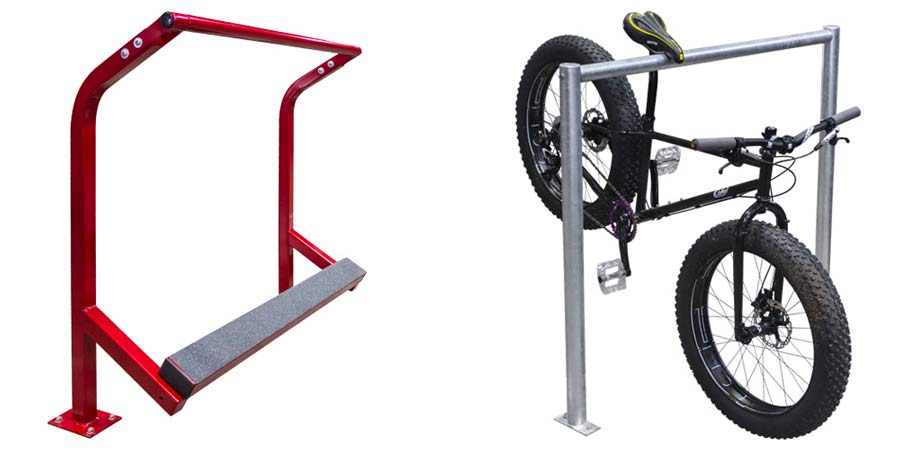 The Biker Bar is a leaning rail designed to give bicyclists a place to rest a hand and foot to balance while waiting at an intersection, never needing to dismount. People on bikes will no longer have to reach for the curb or a sign post to support them at traffic lights. The Biker Bar also acts as a push-off point, assisting riders in getting an efficient start from a full stop. This helps keep traffic moving efficiently and safely through the intersection. The Biker Bar also gives bicyclists a designated area to wait in a queue and out of the crosswalk, so pedestrians have a clear path. The Biker Bar is modular, so depending on the location, it can be extended to accommodate more bicyclists. It is easy to install and includes tamper-proof hardware.
The Saddle Buddy is a perfect amenity for mountain bike trailheads and park rest areas. Its simple design allows bikers to hang bikes from the front of the saddle, keeping them upright. While taking a break or gearing up for the ride ahead, bicyclists no longer need to find a nearby tree to lean their bike on or a patch of grass to lay their bike down. The Saddle Buddy is not designed as a lockable bike rack, but rather a convenient spot for riders who won’t be leaving bikes unattended. Available in galvanized steel to hold up to the elements.
The Biker Bar is a leaning rail designed to give bicyclists a place to rest a hand and foot to balance while waiting at an intersection, never needing to dismount. People on bikes will no longer have to reach for the curb or a sign post to support them at traffic lights. The Biker Bar also acts as a push-off point, assisting riders in getting an efficient start from a full stop. This helps keep traffic moving efficiently and safely through the intersection. The Biker Bar also gives bicyclists a designated area to wait in a queue and out of the crosswalk, so pedestrians have a clear path. The Biker Bar is modular, so depending on the location, it can be extended to accommodate more bicyclists. It is easy to install and includes tamper-proof hardware.
The Saddle Buddy is a perfect amenity for mountain bike trailheads and park rest areas. Its simple design allows bikers to hang bikes from the front of the saddle, keeping them upright. While taking a break or gearing up for the ride ahead, bicyclists no longer need to find a nearby tree to lean their bike on or a patch of grass to lay their bike down. The Saddle Buddy is not designed as a lockable bike rack, but rather a convenient spot for riders who won’t be leaving bikes unattended. Available in galvanized steel to hold up to the elements.










